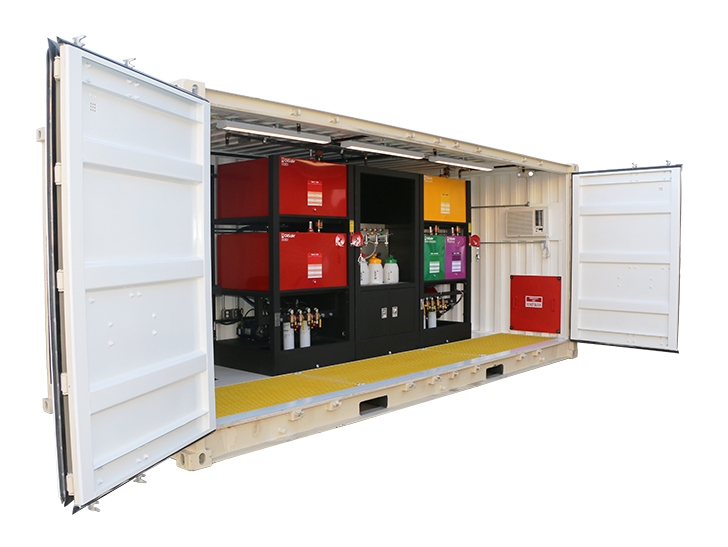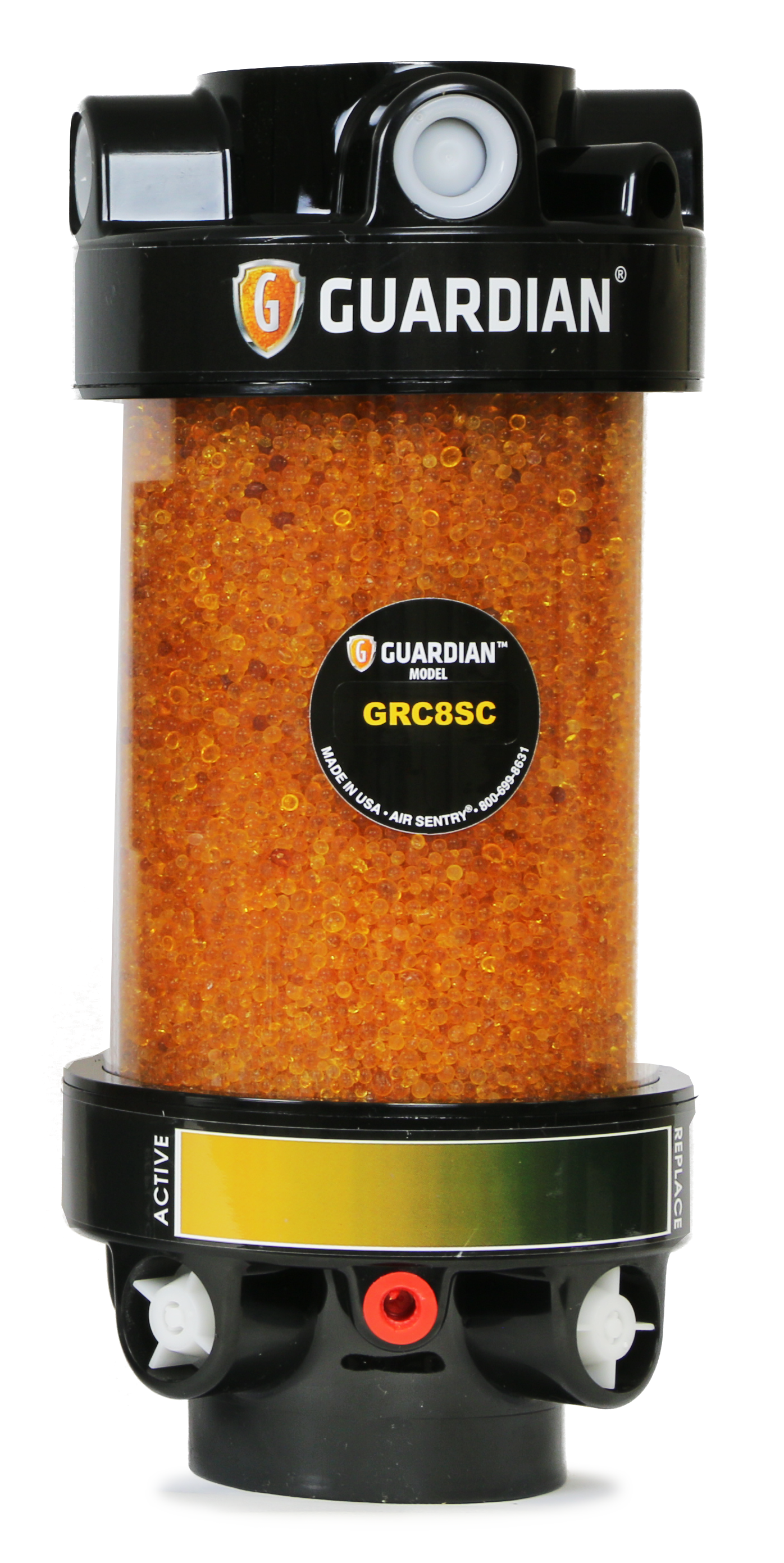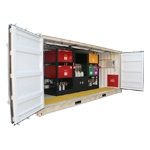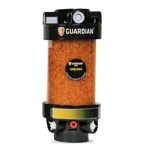

Global Mining: Slick Tricks for an Efficient Fix.
Posted on 02/16/22 in: Technical Knowledge | Published Articles | Mining | Rail | Author: Michael D. Holloway, Bret Jenkins, Don Howard
Both underground and opencast mining operations provide a host of reliability challenges due to the environment of the workspace and the demand the operators place on the equipment. There are several ways in which productivity can be improved through lubrication selection and management.
Using the best performing oil or grease may not be enough, but incorporating a lubrication management system based on sound maintenance strategies can help reduce the overall spend.
Establishing increased productivity through lubrication management considers several aspects: selection, application, storage, condition monitoring and continuous improvement. This article gives an overview of what can be done for short, mid and long-term improvements.

Figure 1. OilSafe® Satellite Lube Room with OilSafe Lubrication Work Center. Units like these help expand reliability and provide organised, contaminate-free lubricant storage and dispensing to remote locations or where indoor space is limited.

Figure 2. Air Sentry® Guardian® Desiccant Breather. Breathers like these in conjunction with OilSafe Adapters reduce contamination, moisture and particulate in equipment.
Lubricant selection
Lubricants are designed to solve problems as a result of heat, friction, wear and contamination. For heavy equipment, most
problems can be characterised into three main groups:
- Excessive load and vibration: the vibration and force applied to a bearing or journal that exceeds the load-carrying capability of the grease. The result is metal-to-metal contact, premature wear and increased heat. This is often seen in bucket pins
and bushings, as well as, bearings in rock crushers. In these applications OEMs often recommend lubricants with moly, a low friction solid lubricant, such as Whitmore® Caliber 5M (a 5%moly grease.) - Excessive or localised heat: excessive heat can be generated during extended operation, or localised heat can result when metal asperities collide, producing pressures in excess of 500 000 psi. Such extreme pressures create heat which break down the grease, leading to cold welding or galling; a form of wear caused by adhesion between sliding surfaces. Thermally stable lubricants maintain consistency and exceptional load carrying capabilities which excel in this situation.
- Contamination: sand, mud, water and steam can wash away grease, leaving metal unprotected. Dust, fibres and abrasive particles can combine with grease and grind away metal. Acids, caustics and cleaning solutions can break down grease and corrode metal.
When selecting or replacing an existing product, consider the physical performance characteristics of the grease or oil. A few rules of thumb to go by when beginning the productivity journey are as follows:
- Synthetic-based oils and greases often perform better and last longer than mineral-based products when put in high heat/high stress environments, but they will cost more. Their value can often be seen in extended drain intervals and component life and especially in conjunction with a high efficiency desiccant breather where oils are concerned.
- Strive to use the absolute minimum of different oils and greases. Stay within the viscosity requirements yet look to consolidate as much as possible, this will make storage, application and procurement much more streamlined.
- When selecting a grease, the base oil viscosity is vitally important. Higher base oil viscosity for high load and low speed, lower viscosity for high speed applications.
- Examine past maintenance records and conduct informal interviews with the operators and maintenance staff. Often, they can provide true application experience about a certain product that is not immediately recognised.
- Refer to the technical data/product sheet for the product performance assessment and specifications it meets. The lubricant sales representative or distributor can point you in the right direction.
- Compare standardised testing methods ASTM, DIN and ISO procedures. Non-standardised tests are usually biased and often misleading. Many lubricants tested by non-standard methods are often non-conforming with industry norms and OEM requirements.
Lubricant application
While many bearings are considered ‘lubed for life’, there are still many bearings that require grease on a periodic basis. The most common application to grease a bearing is with a grease gun. There are several varieties: level action, air powered and pistol grip. A grease lubricated bearing can be manually applied, as well as, automatically (semi or fully) applied or lubricated for the life of the bearing.
The application of an oil can be broken down into a total loss application, a self-contained application, or a circulating application. The total loss, or once-through oiling, is so named because the oil passes through the application only once and is lost for further use. It is also called ‘all loss’ oiling because the oil is used only once. Methods of this type include hand oiling, drop feed oiling, wick-feed oiling and bottle oiling.
Hand oiling is the direct application of oil to a moving machine part from a hand oil can. An excess of oil is applied, which soon runs off, leaving the bearing to operate with insufficient oil until the next oiling. For this reason, bearings lubricated by hand oiling are not as well protected against wear as those on which more reliable oiling methods are used.
Drop feed oilers usually consist of a glass or plastic reservoir, a needle valve feed rate adjustment, a snap level shut-off and a sight glass for observing the feed rate. They are generally used on lightly loaded, horizontal bearings that require a low rate of oil supply.
Using a labelled tagging system, as well as, a contained oil applicator will reduce the incidence of cross-contamination.
Lubricant storage
Proper storage of oils and grease is an essential part of a proactive maintenance strategy. The objectives for storage guidelines should include:
- Minimise the total volume in stores.
- Minimise the number of product types to lowest reasonable minimum.
- Minimise the amount of open atmosphere stores.
- Minimise lubricant storage cycle, optimise shelf life.
- Maintain stable storage temperatures, ≤ 100°F, ≥ 60°F.
To minimise the total volume in stores requires a pursuit of a 'safe' level of lubricant consolidation, typically that would be a 24 hour requirement for locally stored products. It is also important to secure next day service, and delivery and purchase in bulk if possible and delivered to the sub-station level. In order to minimise cross-contamination and confusion minimise the number of product types to lowest reasonable count. There should be no more than one viscosity grade for each product type (AW, EP, R&O).
Whenever possible, recognise OEM guidance for additive and viscosity grades, not brand allegiance. Purchasing quality lubricants is or should be a minimum part of the maintenance budget. Poor oil and grease storage have shown to cause as much as 40% of the total equipment maintenance cost. Contamination from compromised storage can produce 70 - 80% of machine wear and can be attributed to storage derived contamination. A proactive maintenance programme that is supported by management and focuses on contamination, lubrication and reliability can extend equipment life by 10 times.
Contamination control
Contamination is responsible for most failure opportunities in a lubricated system. A proven practice to reduce water and particulate contamination is using filters and reservoir air breathers.
A reservoir air breather design allows outside air to enter through an opening in the breather's top cap. There are top cap designs that overhang the body of the breather protecting it from rain, sleet, snow, dirt and dust, as well as most equipment wash-down procedures. When contaminated air enters the top of the breather, it may pass through a self-cleaning, solid particle filter depending on the manufacturer.
These filters trap solid particles greater than 2 μm, keeping them from entering the breather inner core which ultimately wear on your equipment. Typically, the filtered air then passes through a bed of silica gel that adsorbs moisture in the air. During this step, up to 95% of the water vapour in the air is absorbed.
In higher end models, the filtered air passes through an additional 2 μm filter in the bottom of the breather to ensure that no harmful particles will enter the tank or reservoir. As the colour indicating silica gel adsorbs moisture it changes from one color to another. This colour change is easily seen and serves as the visual indication that it is time to remove and replace the disposable breather.
It has been determined that more than 75% of all machine wear related failures were due to particulate contaminants. Frequently, the greatest cost of equipment failure is not the component replacement cost, but the labour production downtime. Most particles start off as dirt that becomes airborne, then find its way into lubricant and fuel reservoirs, and is later transported to bearings, bushings, seals, valves and other machine components.
There they become key ingredients in abrasion, erosion and fatigue failures. The contaminants also cause lubricant degradation, shortening the life of the lubricant and decreasing its ability to lubricate. With machine clearances measured in thousandths of an inch, it does not take much contamination to affect bearings and other sensitive components. Even particles of 10 μm or smaller can disrupt the lubricant film and cause a great amount of wear.
Condition monitoring
A variety of methods are available to assess the condition of systems/equipment to determine the most effective time to schedule maintenance.
These methods include vibration monitoring and analysis, thermography, passive ultrasonic, lubricant and particle wear analysis, electrical condition monitoring and non-destructive testing. A reliability-centred maintenance approach utilises these tools to establish a reliability entitlement for their equipment resulting in a drastic decrease in downtime, parts replacement and labour costs.
The process used determines what must be done to ensure that the physical assets continue to do what they were intended to do in their operating context by utilising various condition monitoring tools. This blend of condition monitoring tools paired with an RCM smart data base utilises a custom developed analytical tool which captures, analyses and predicts the likelihood of component failure, as well as, the cost associated if the developing failure.
Continuous improvement
Reliability is defined as an attribute of any system that consistently produces the same results preferably meeting or exceeding its specifications. To increase reliability, we must decrease failure. Failure finds its source in man, machines, materials and methods but regardless of the source, this requires change.
Managing change is no easy task, fortunately, there are elements to the process of change that when followed will increase successful change. The elements include establishing the vision or goal. Next, provide resources, skills and incentives for change, and lastly, setting forth a plan on the tasks required. Goals can consist of many categories, which include but may not be limited to equipment management, lubrication management and maintenance management.
Goals
Without goals being set, individuals, teams or departments will lack direction and will be confused as to the intent of the work being asked. The goals should be tied into key performance indicators and should be established according to a metric such as money or a percentage that can be traced.
Competency development
In order to establish change, competency must be developed. Research from the Rand Corporation, US News and World Report, as well as several professional societies, indicate that a moderate amount of training is required for employees to assume their current role in the industry. Training and competency development opportunities are one of the most important factors employees look for when choosing their role. Many believe that a lack of training and development holds them back in their career. Employees who feel they cannot develop in a company and fulfil their career goals are 12 times more likely to leave the company, according to research by Rand Corporation. In terms of lubrication that can be understanding and applying content, such as:
- Lubrication fundamentals.
- Product formulas (base oils, additives).
- Failure sources.
- Lubricant application.
- Storage and contamination management.
Guided instruction, in-house or off-site classes and technical conferences can provide the required content for developing competency. If skills are not established, anxiety will follow and become a barrier in reducing failure.
Action plan
When the goal is in place and the skills being developed, the resources allocated and the incentives are realised, it is now time to establish the plan of action. The plan should have several aspects all relating back to the goal.
In terms of lubrication productivity improvements, the technician should have a lubrication route established, this can be structured according to grouping tasks by product type, geography and machine type. Part of the tasks carried out by the technicians involved in equipment lubrication would be equipment sampling. Selecting equipment for oil and grease analysis has several considerations, choose according to the following:
Equipment with measurable failure patterns.
- Critical equipment.
- Equipment subject to known/unknown wear.
- Systems which failure may be induced by incorrect preventive maintenance.
- Testing frequency.
- Machine age.
- Machine reliability and service record.
- Oil age.
- Application.
- Duty cycle.
- Work environment.
Best practices for lubrication productivity include establishing consistent procedures, determining the optimal greasing and sampling points that provide the best information, ensuring safe sample application and extraction methods, minimising sources of garbage data due to sampling location, filling out required sample information and establishing procedures for forwarding samples to the laboratory in a timely manner (within a day of sampling).
Creating a lubrication management and condition monitoring plan is essential for increasing the overall reliability and productivity of assets in the operation. Developing competency in conjunction with providing resources and incentives will help ensure that the action plan set forth for the overall goals are met.

